A Novel Modified Super-Twisting Control Augmented Feedback Linearization for Wearable Robotic Systems Using Time Delay Estimation
Abstract
1. Introduction
- In the feedback linearization approach adopted in this paper, the dynamic model of the robot is transformed into a simpler form. Based on this form, the control law is derived. By employing a suitable transformation to this control law, it becomes usable to the original physical system, while it is excellent for trajectory planning/following tasks.
- Develop a control law based on a modified super-twisting controller with Time Delay Estimation (TDE) that supplies an approximation of uncertainties and external disturbances by using a step into the past of the inputs and the output of the system.
- An adaptive exponential term function of the switching surface called exponential reaching law (ERL) is integrated with the proposed reaching law. The ERL presents a kind of adaptation of the switching gains. If the tracking error value becomes large, the switching gains become large too, such as a faster convergence during the reaching phase is realized. The switching gains become small, e.g., the phenomenon of chattering is reduced during the sliding phase.
- Experimental studies conducted using a new exoskeleton robot named Smart Robotic Exoskeleton (SREx) to evaluate the proposed control scheme’s performance with respect to providing excellent tracking, small steady-state error, and reduced chattering.
2. Manipulator Robot Mathematical Characterization
2.1. Robot Modelling
2.2. Robot Manipulator Input/Output Linearization
2.3. Problem Formulation
- Assumption 1: Joint position and velocity are measurable.
- Assumption 2: The matrix is assumed to be bounded and invertible.
- Assumption 3: The pseudo-Jacobian matrix is non-singular.
- Assumption 4: Desired trajectory is bounded.
- Assumption 5: The uncertain functions are continuously differentiable concerning the time variable and do not vary largely during a small period.
- Assumption 6: The velocity and the acceleration outputs of the system are bounded.
2.4. Control Design
3. Experimental Results
3.1. Smart Robotic Exoskeleton (SREx) Model
3.2. Real-Time Setup
3.3. Experiment Results of the Proposed Controller
3.4. Experiment Results of the Conventional Super-Twisting Controller (STSMC)
4. Comparative Study
5. Conclusions
Author Contributions
Funding
Institutional Review Board Statement
Informed Consent Statement
Acknowledgments
Conflicts of Interest
Appendix A
Appendix A.1. Definition of the Lipchitz Constant
Appendix A.2. Stability Condition
Appendix A.3. The Workspace and DH-Parameters of SREx
| Joints | Motion | Workspace |
|---|---|---|
| 1 | Shoulder joint horizontal flexion/extension | 0°/140° |
| 2 | Shoulder joint vertical flexion/extension | 140°/0° |
| 3 | Shoulder joint internal/external rotation | 85°/75° |
| 4 | Elbow joint flexion/extension | 120°/0° |
| 5 | Forearm joint pronation/supination | 85°/85° |
| 6 | Wrist joint ulnar/radial deviation | 30°/20° |
| 7 | Wrist joint flexion/extension | 50°/60° |
| Joint (i) | αi−1 | ai−1 | di | θi |
|---|---|---|---|---|
| 1 | 0 | 0 | ds | θ1 |
| 2 | −π/2 | 0 | 0 | θ2 |
| 3 | π/2 | 0 | de | θ3 |
| 4 | −π/2 | 0 | 0 | θ4 |
| 5 | π/2 | 0 | dw | θ5 |
| 6 | −π/2 | 0 | 0 | θ6 − π/2 |
| 7 | −π/2 | 0 | 0 | θ7 |
References
- De Morand, A. Pratique de la Rééducation Neurologique; Elsevier Masson: Paris, France, 2014. [Google Scholar]
- Xie, S. Advanced Robotics for Medical Rehabilitation; Springer: Cham, Switzerland, 2016. [Google Scholar]
- Brahim, B.; Maarouf, S.; Luna, C.O.; Abdelkrim, B.; Rahman, M.H. Adaptive iterative observer based on integral backstepping control for upper extremity exoskelton robot. In Proceedings of the 2016 8th International Conference on Modelling, Identification and Control (ICMIC), Algiers, Algeria, 15–17 November 2016; pp. 886–891. [Google Scholar]
- Brahim, B.; Rahman, M.H.; Saad, M.; Luna, C.O. Iterative Estimator-Based Nonlinear Backstepping Control of a Robotic Exoskeleton. Int. J. Mech. Mechatron. Eng. 2016, 10, 1313–1319. [Google Scholar]
- Brahmi, B.; El Bojairami, I.; Saad, M.; Driscoll, M.; Zemam, S.; Laraki, M.H. Enhancement of Sliding Mode Control Performance for Perturbed and Unperturbed Nonlinear Systems: Theory and Experimentation on Rehabilitation Robot. J. Electr. Eng. Technol. 2021, 16, 599–616. [Google Scholar] [CrossRef]
- Slotine, J.-J.E.; Li, W. Applied Nonlinear Control; Prentice-Hall: Englewood Cliffs, NJ, USA, 1991; Volume 199. [Google Scholar]
- Gao, F.; Lin, F.-X.; Liu, B. Distributed H∞ Control of Platoon Interacted by Switching and Undirected Topology. Int. J. Automot. Technol. 2020, 21, 259–268. [Google Scholar] [CrossRef]
- Young, K.D.; Utkin, V.I.; Özgüner, Ü. A control engineer’s guide to sliding mode control. IEEE Trans. Control Syst. Technol. 1999, 7, 328–342. [Google Scholar] [CrossRef]
- Khalil, H.K.; Grizzle, J. Nonlinear Systems; Prentice Hall: Upper Saddle River, NJ, USA, 1996; Volume 3. [Google Scholar]
- Shieh, H.-J.; Hsu, C.-H. An Adaptive Approximator-Based Backstepping Control Approach for Piezoactuator-Driven Stages. IEEE Trans. Ind. Electron. 2008, 55, 1729–1738. [Google Scholar] [CrossRef]
- Fridman, L. The problem of chattering: An averaging approach. In Variable Structure Systems, Sliding Mode and Nonlinear Control; Springer: Berlin/Heidelberg, Germany, 1999; pp. 363–386. [Google Scholar]
- Moreno, J.A.; Osorio, M. A Lyapunov approach to second-order sliding mode controllers and observers. In Proceedings of the 2008 47th IEEE Conference on Decision and Control, Cancun, Mexico, 9–11 December 2008; pp. 2856–2861. [Google Scholar]
- Derafa, L.; Benallegue, A.; Fridman, L. Super twisting control algorithm for the attitude tracking of a four rotors UAV. J. Frankl. Inst. 2012, 349, 685–699. [Google Scholar] [CrossRef]
- Kamal, S.; Chalanga, A.; Bera, M.K.; Bandyopadhyay, B. State estimation and non vanishing unmatched disturbance reconstruction using modified super twisting algorithm. In Proceedings of the 2012 7th International Conference on Electrical and Computer Engineering, Dhaka, Bangladesh, 20–22 December 2012; pp. 941–944. [Google Scholar]
- Chen, P.; Chen, C.; Chiang, W. GA-based modified adaptive fuzzy sliding mode controller for nonlinear systems. Expert Syst. Appl. 2009, 36, 5872–5879. [Google Scholar] [CrossRef]
- Wang, L.; Chai, T.; Zhai, L. Neural-Network-Based Terminal Sliding-Mode Control of Robotic Manipulators Including Actuator Dynamics. IEEE Trans. Ind. Electron. 2009, 56, 3296–3304. [Google Scholar] [CrossRef]
- Dávila, A.; Moreno, J.A.; Fridman, L. Variable gains super-twisting algorithm: A Lyapunov based design. In Proceedings of the 2010 American Control Conference (ACC), Baltimore, MD, USA, 30 June–2 July 2010; pp. 968–973. [Google Scholar]
- Brahmi, B.; Saad, M.; Rahman, M.H.; Brahmi, A. Adaptive Force and Position Control Based on Quasi-Time Delay Estimation of Exoskeleton Robot for Rehabilitation. IEEE Trans. Control Syst. Technol. 2019, 28, 2152–2163. [Google Scholar] [CrossRef]
- Brahmi, B.; Saad, M.; Ochoa-Luna, C.; Rahman, M.H.; Brahmi, A. Adaptive Tracking Control of an Exoskeleton Robot with Uncertain Dynamics Based on Estimated Time-Delay Control. IEEE/ASME Trans. Mechatron. 2018, 23, 575–585. [Google Scholar] [CrossRef]
- Bartoszewicz, A. A new reaching law for sliding mode control of continuous time systems with constraints. Trans. Inst. Meas. Control 2015, 37, 515–521. [Google Scholar] [CrossRef]
- Draženović, B. The invariance conditions in variable structure systems. Automatica 1969, 5, 287–295. [Google Scholar] [CrossRef]
- Chen, W.; Saif, M. A variable structure controller for a class of uncertain systems with unknown uncertainty bounding function. In Proceedings of the 2006 American Control Conference, Mineapolis, MN, USA, 14–16 June 2006; p. 6. [Google Scholar]
- Moreno, J.A. A linear framework for the robust stability analysis of a generalized super-twisting algorithm. In Proceedings of the 2009 6th International Conference on Electrical Engineering, Computing Science and Automatic Control, CCE, Toluca, Mexico, 10–13 January 2009; pp. 1–6. [Google Scholar]
- Moreno, J.A. Lyapunov approach for analysis and design of second order sliding mode algorithms. In Sliding Modes after the First Decade of the 21st Century; Fridman, L., Moreno, J., Iriarte, R., Eds.; Springer: Berlin/Heidelberg, Germany, 2011; pp. 113–149. [Google Scholar]
- Plestan, F.; Shtessel, Y.B.; Brégeault, V.; Poznyak, A. New methodologies for adaptive sliding mode control. Int. J. Control 2010, 83, 1907–1919. [Google Scholar] [CrossRef]
- Shtessel, Y.B.; Moreno, J.A.; Plestan, F.; Fridman, L.M.; Poznyak, A.S. Super-twisting adaptive sliding mode control: A Lyapunov design. In Proceedings of the 49th IEEE Conference on Decision and Control (CDC), Atlanta, GA, USA, 15–17 December 2010; pp. 5109–5113. [Google Scholar]
- Brahmi, B.; Saad, M.; Rahman, M.H.; Ochoa-Luna, C. Cartesian Trajectory Tracking of a 7-DOF Exoskeleton Robot Based on Human Inverse Kinematics. IEEE Trans. Syst. Man Cybern. Syst. 2017, 49, 600–611. [Google Scholar] [CrossRef]
- Brahmi, B.; Saad, M.; Brahmi, A.; Luna, C.O.; Rahman, M.H. Compliant control for wearable exoskeleton robot based on human inverse kinematics. Int. J. Adv. Robot. Syst. 2018, 15, 1729881418812133. [Google Scholar] [CrossRef]
- Luna, C.O.; Rahman, M.H.; Saad, M.; Archambault, P.S.; Zhu, W.-H. Virtual decomposition control of an exoskeleton robot arm. Robotica 2014, 34, 1587–1609. [Google Scholar] [CrossRef]
- Hu, X.; Tong, K.; Song, R.; Zheng, X.; Lui, K.; Leung, W.W.-F.; Ng, S.; Au-Yeung, S. Quantitative evaluation of motor functional recovery process in chronic stroke patients during robot-assisted wrist training. J. Electromyogr. Kinesiol. 2009, 19, 639–650. [Google Scholar] [CrossRef] [PubMed]
- Sadeque, M.; Balachandran, S.K. Overview of medical device processing. Trends Dev. Med. Devices 2020, 177–188. [Google Scholar] [CrossRef]
- Resquín, F.; Gonzalez-Vargas, J.; Ibáñez, J.; Brunetti, F.; Pons, J.L. Feedback Error Learning Controller for Functional Electrical Stimulation Assistance in a Hybrid Robotic System for Reaching Rehabilitation. Eur. J. Transl. Myol. 2016, 26. [Google Scholar] [CrossRef] [PubMed]
- Shifrin, T. Multivariable Mathematics: Linear Algebra, Multivariable Calculus, and Manifolds; John Wiley & Sons: Hoboken, NJ, USA, 2005. [Google Scholar]
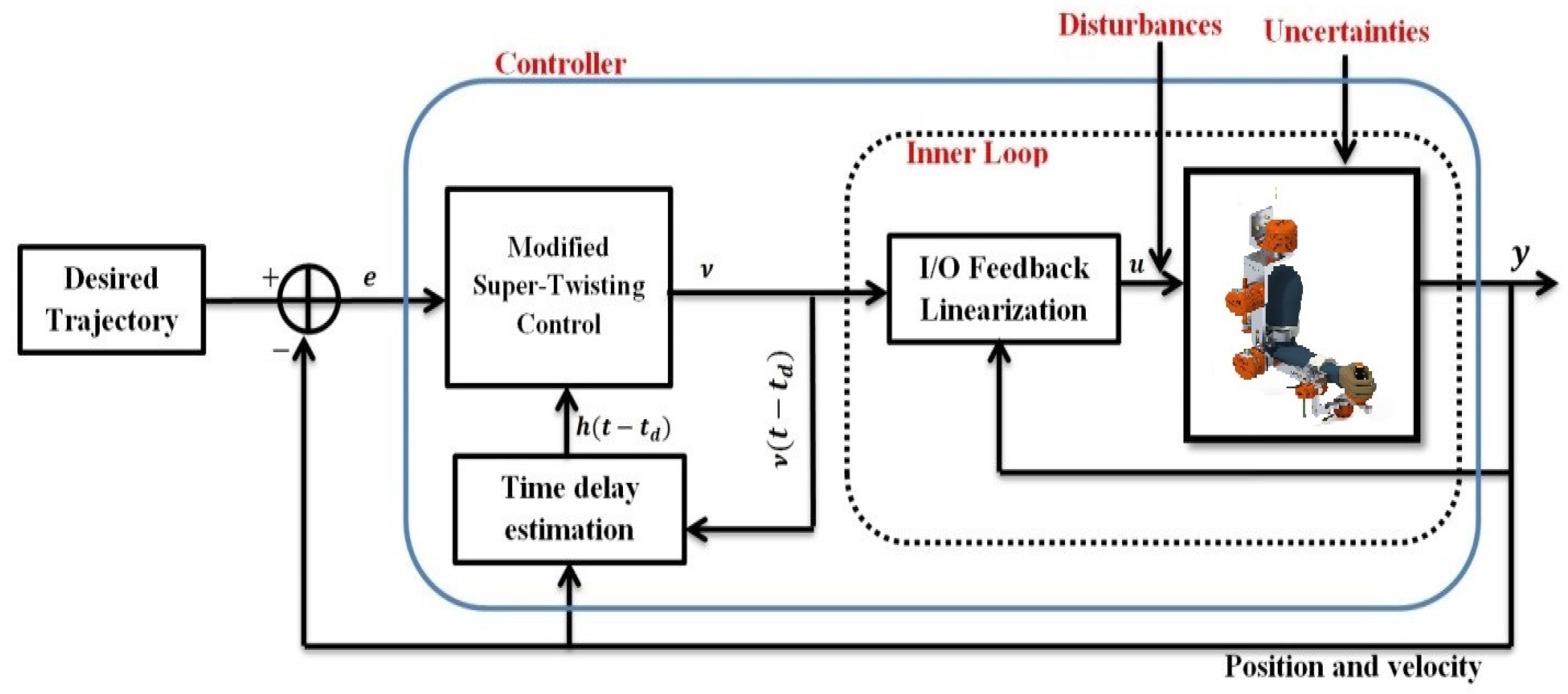

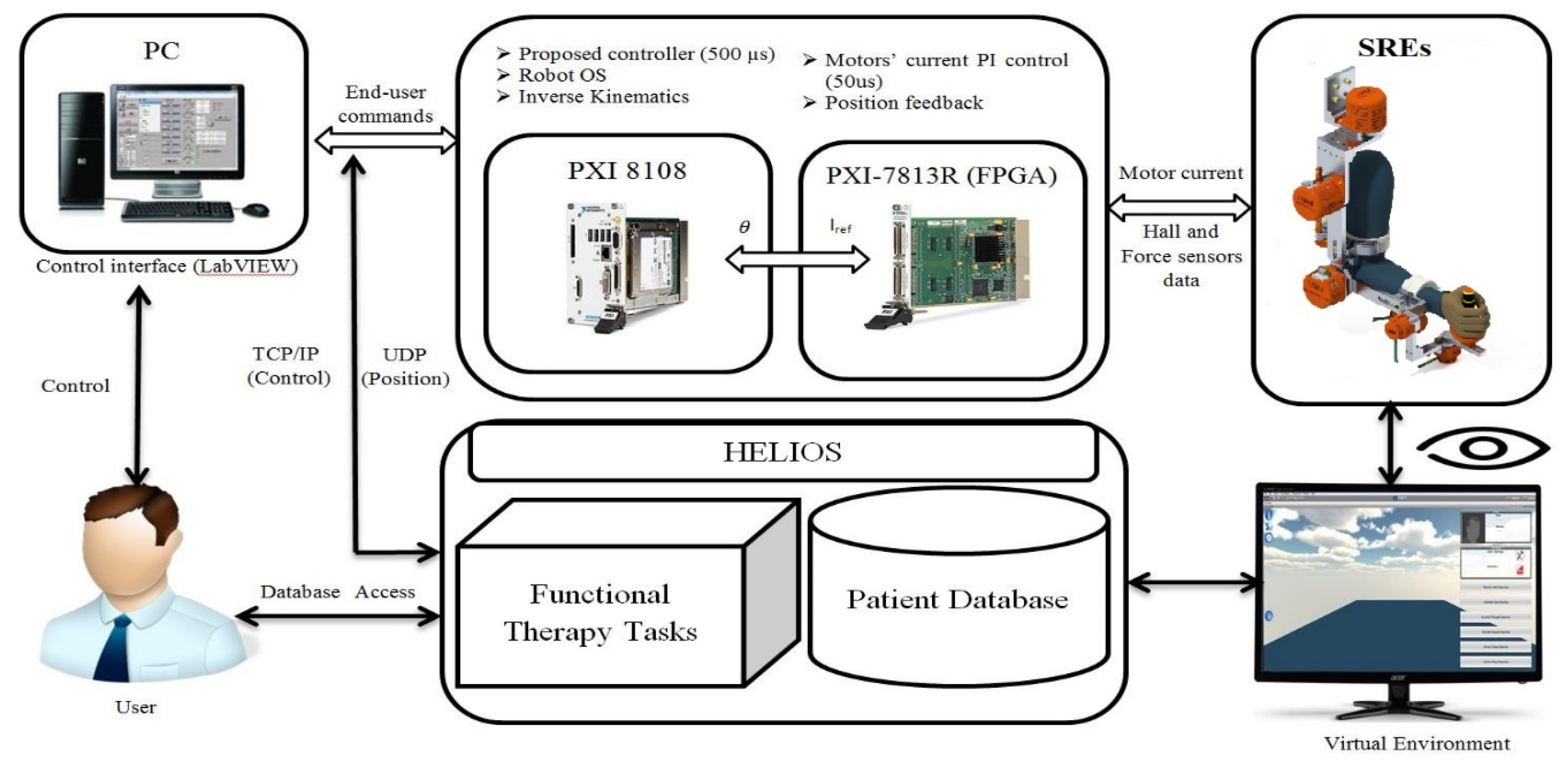

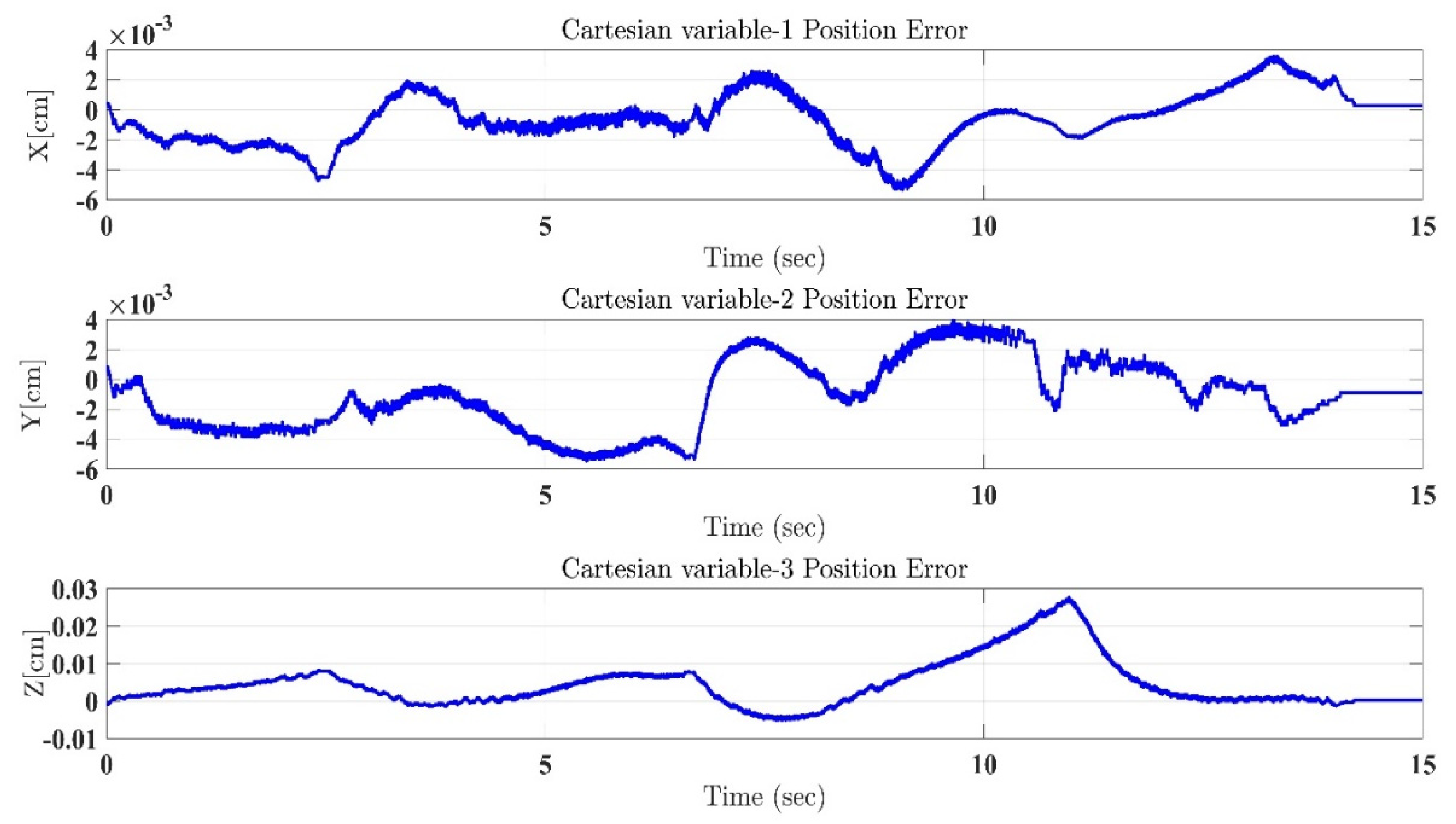
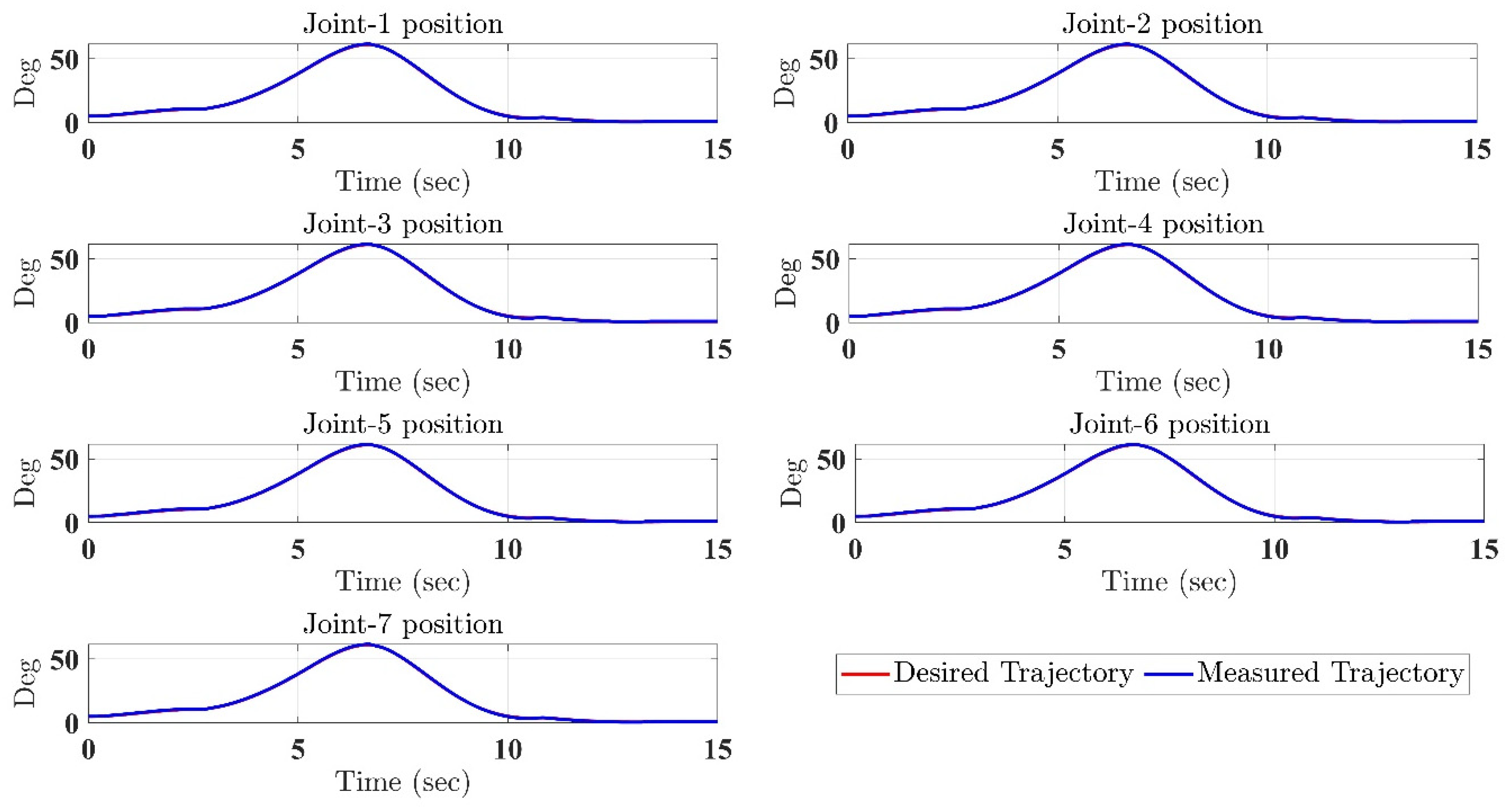
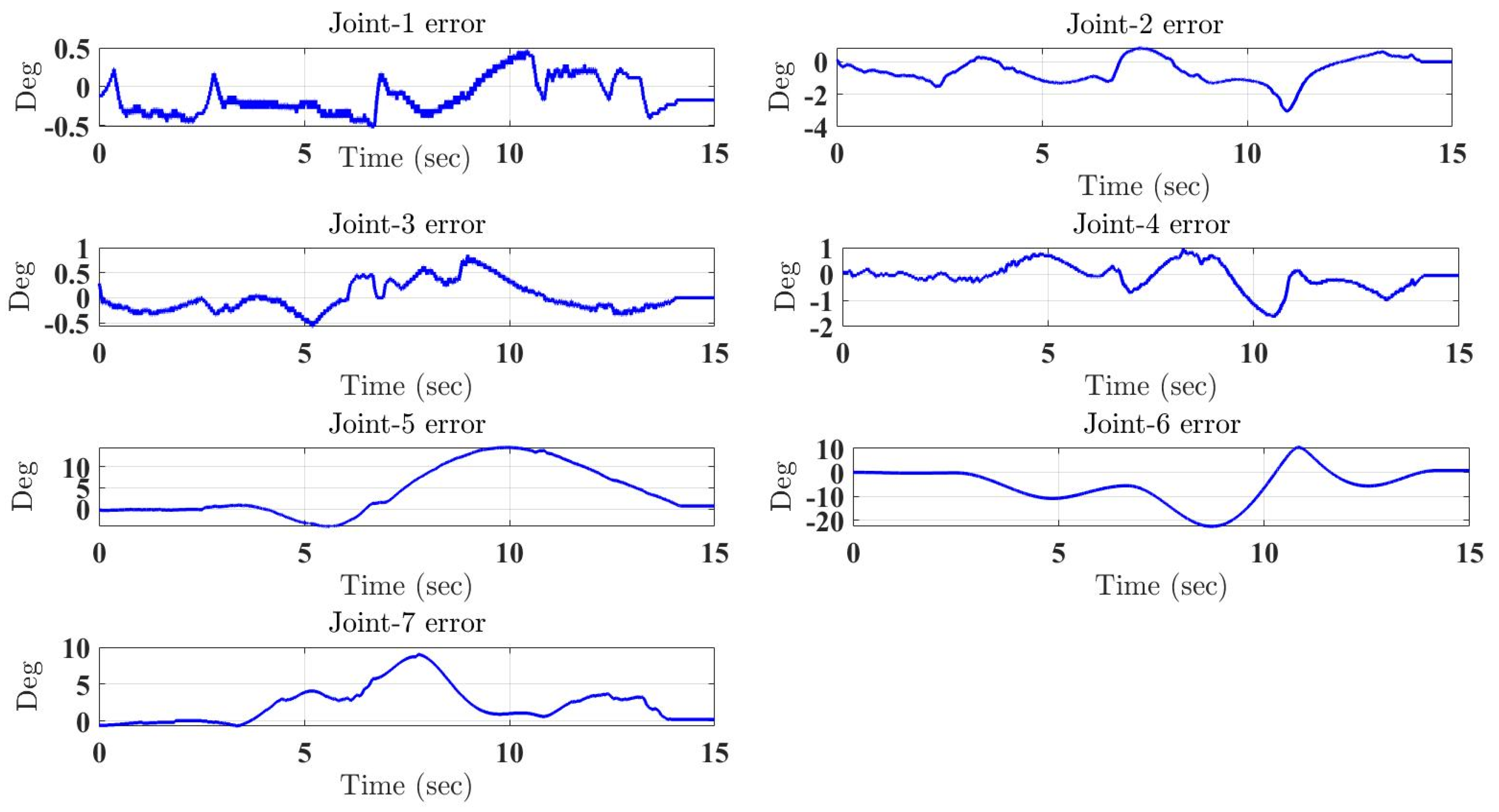
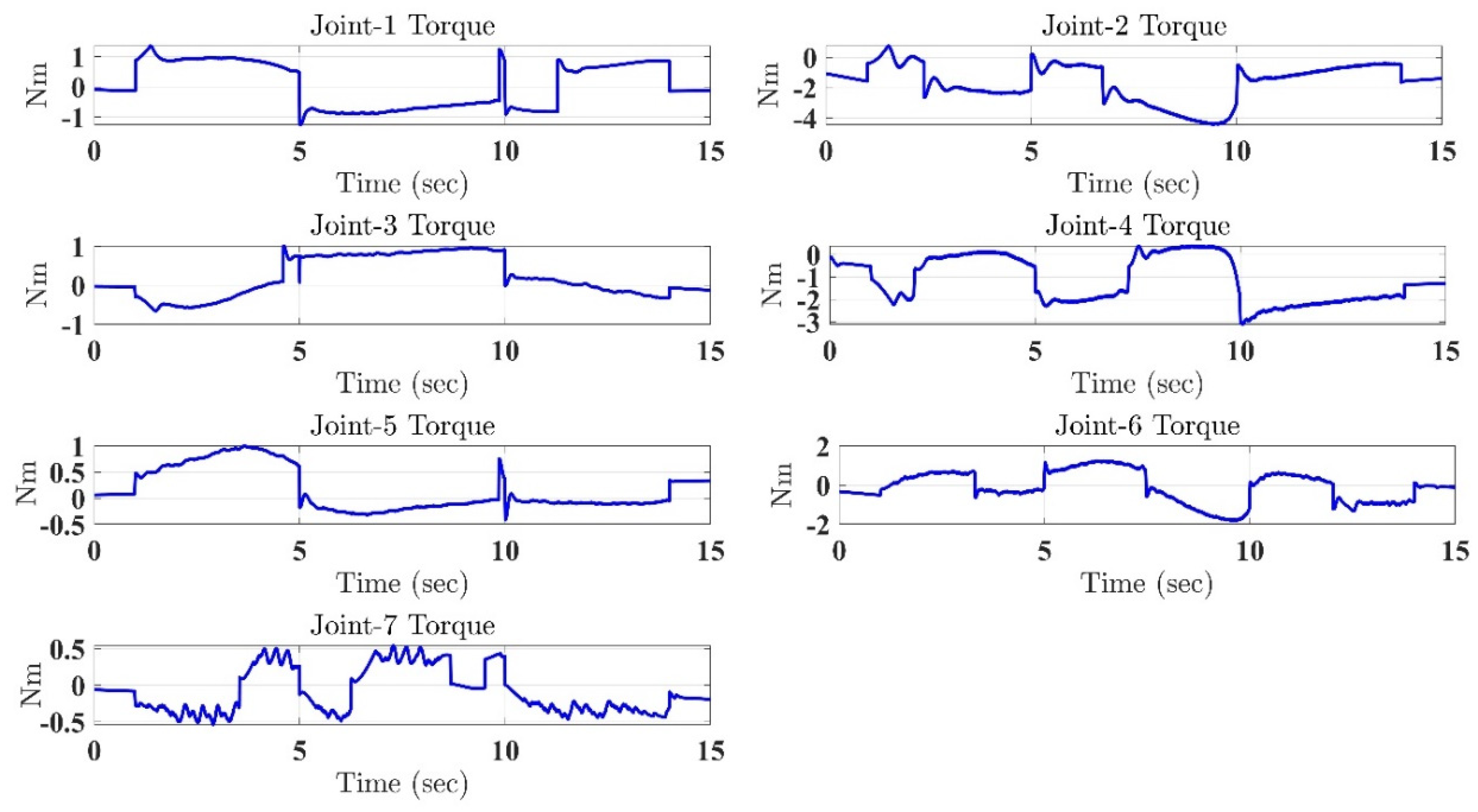

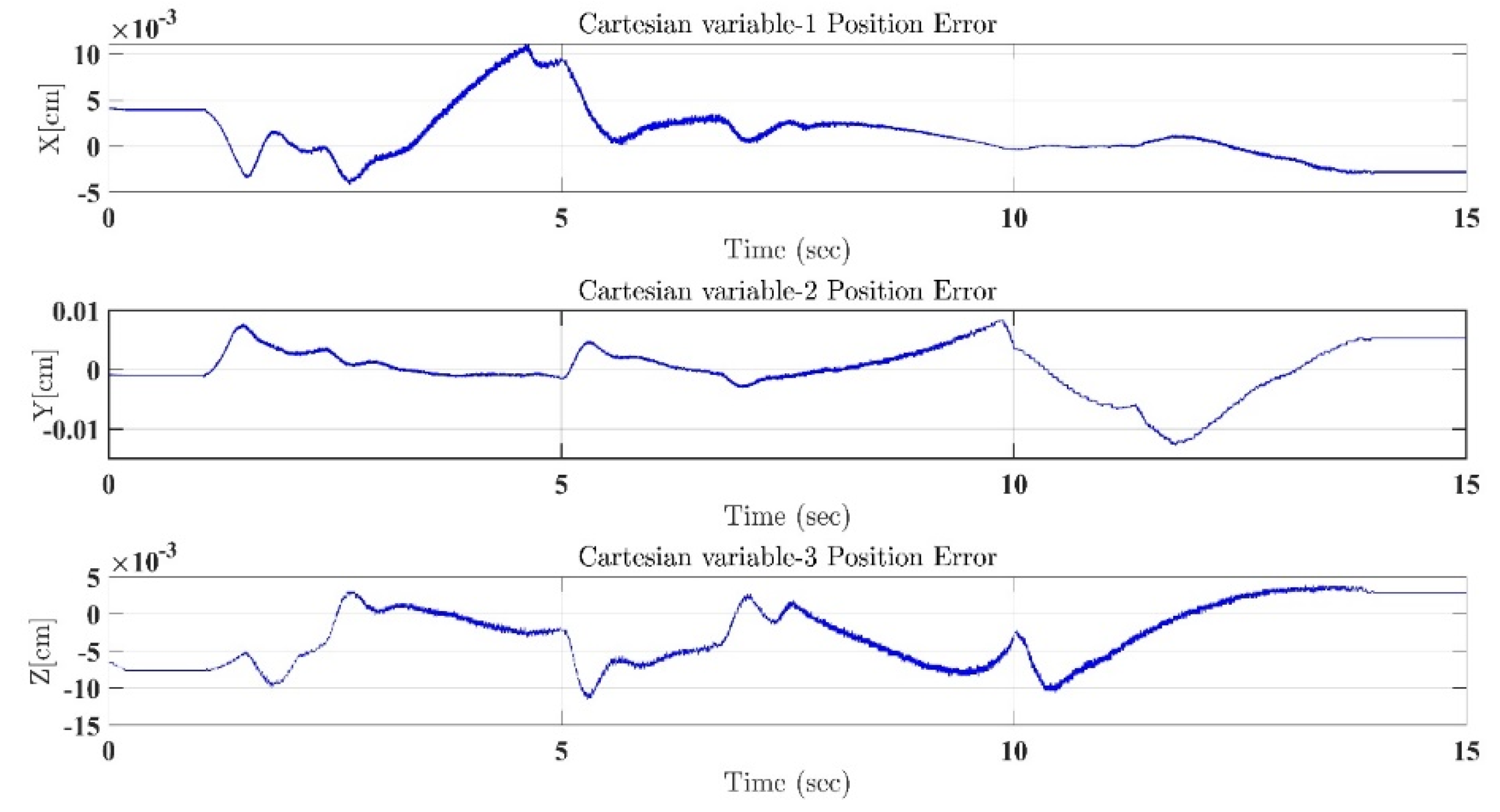
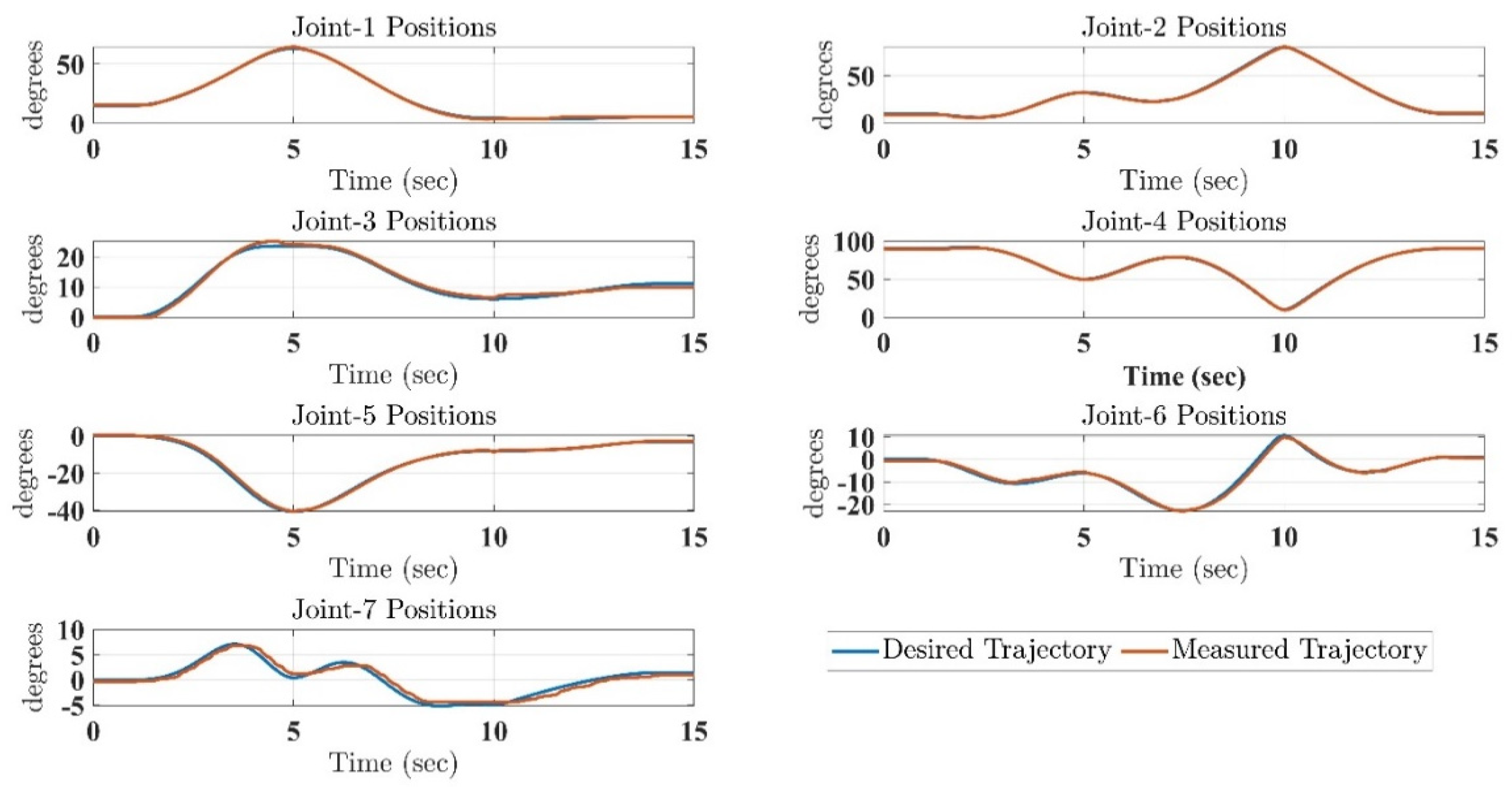

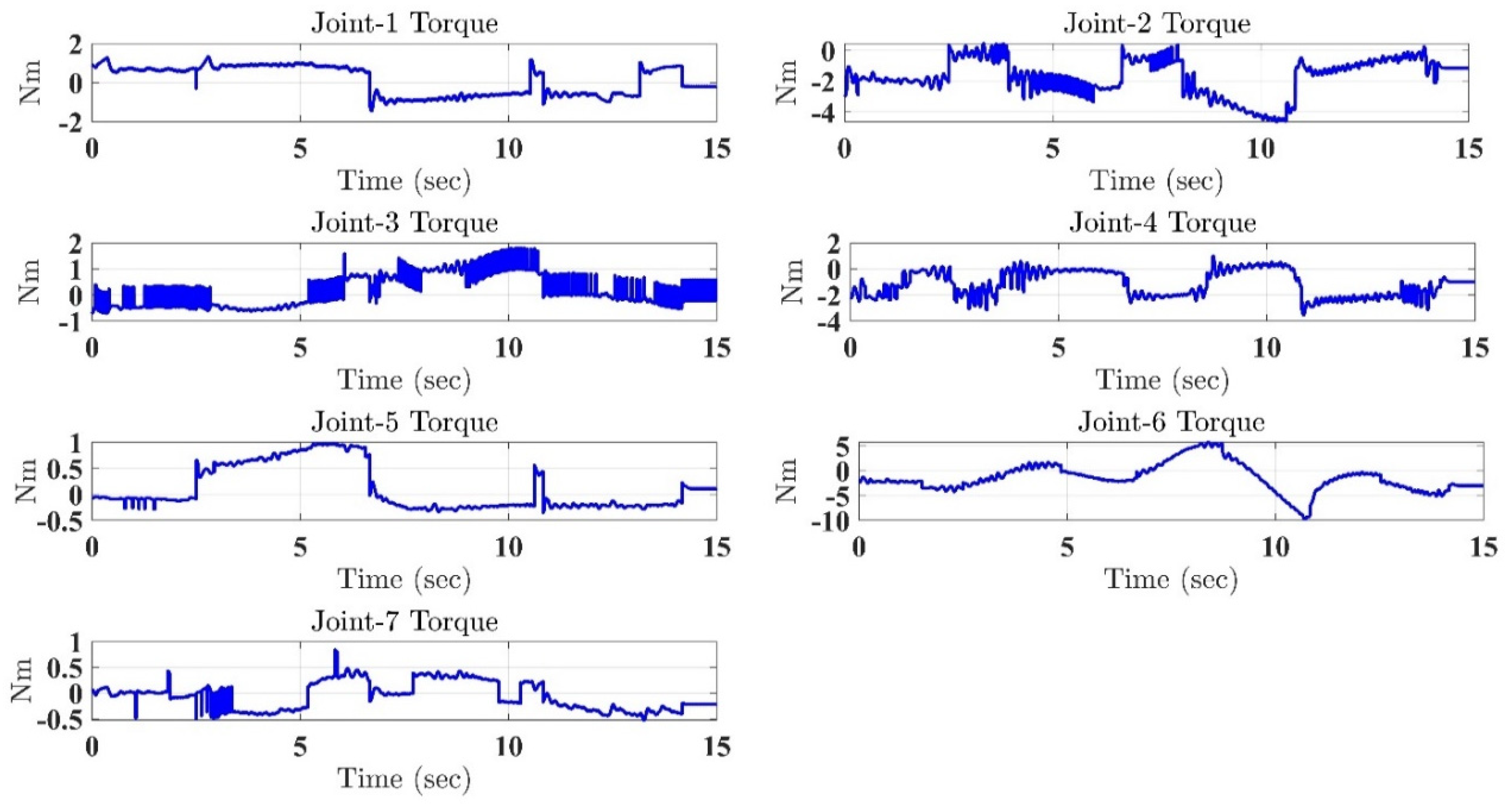
| Constants | Value (i = 1:7) |
|---|---|
| 3.2 | |
| 10 | |
| 2 | |
| 0.5 | |
| 1/2 | |
| 15 |
| Subjects | Root Mean Square (RMS) | |||
|---|---|---|---|---|
| MSTFLTDC Controller | STSMC Controller | |||
| Subject-A | 0.0150 | 2.6908 | 0.0588 | 3.2147 |
| Subject-B | 0.0129 | 2.5811 | 0.0544 | 3.3827 |
Publisher’s Note: MDPI stays neutral with regard to jurisdictional claims in published maps and institutional affiliations. |
© 2021 by the authors. Licensee MDPI, Basel, Switzerland. This article is an open access article distributed under the terms and conditions of the Creative Commons Attribution (CC BY) license (https://creativecommons.org/licenses/by/4.0/).
Share and Cite
Brahmi, B.; El Bojairami, I.; Ahmed, T.; Swapnil, A.A.Z.; AssadUzZaman, M.; Wang, I.; McGonigle, E.; Rahman, M.H. A Novel Modified Super-Twisting Control Augmented Feedback Linearization for Wearable Robotic Systems Using Time Delay Estimation. Micromachines 2021, 12, 597. https://doi.org/10.3390/mi12060597
Brahmi B, El Bojairami I, Ahmed T, Swapnil AAZ, AssadUzZaman M, Wang I, McGonigle E, Rahman MH. A Novel Modified Super-Twisting Control Augmented Feedback Linearization for Wearable Robotic Systems Using Time Delay Estimation. Micromachines. 2021; 12(6):597. https://doi.org/10.3390/mi12060597
Chicago/Turabian StyleBrahmi, Brahim, Ibrahim El Bojairami, Tanvir Ahmed, Asif Al Zubayer Swapnil, Mohammad AssadUzZaman, Inga Wang, Erin McGonigle, and Mohammad Habibur Rahman. 2021. "A Novel Modified Super-Twisting Control Augmented Feedback Linearization for Wearable Robotic Systems Using Time Delay Estimation" Micromachines 12, no. 6: 597. https://doi.org/10.3390/mi12060597
APA StyleBrahmi, B., El Bojairami, I., Ahmed, T., Swapnil, A. A. Z., AssadUzZaman, M., Wang, I., McGonigle, E., & Rahman, M. H. (2021). A Novel Modified Super-Twisting Control Augmented Feedback Linearization for Wearable Robotic Systems Using Time Delay Estimation. Micromachines, 12(6), 597. https://doi.org/10.3390/mi12060597









